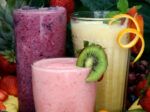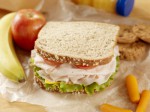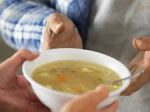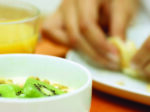 Juice extraction has become the latest dietary fad and one of the easiest ones to sell.
Juice extraction has become the latest dietary fad and one of the easiest ones to sell.
After all eating more fruits and vegetables (5+ servings/d day in NZ;6-8 servings in USA) is encouraged world-wide by health authorities for better health.
The sales pitch
Juicing sounds appealing for a number of reasons. Juice promoters claim that:
- It adds variety to the diet and may encourage people to try fruits and vegetables they would not normally eat.
- With no chewing required it is an efficient way for busy people and young children to consume their fruits and vegetables
- Juicing enables all the vitamins and minerals to be broken down sufficiently to be absorbed.
- For people who are overweight, suffer from high blood pressure , diabetes or high cholesterol levels juice promoters recommend less fruit juice (other than limes or lemons) and more vegetables as a way of avoiding the sugars and fructose that can cause metabolic complications and bloating.
How does the juice diet work?
Juice promoters recommend the following:
- To use organically grown fruits and vegetables
- To use pesticide free celery, spinach, kale, collard greens, lettuce, carrots and cucumber
- To begin with celery, fennel and cucumber before moving onto red and green lettuce, endive and spinach and then finally cabbage and bitter vegetables such as kale, dandelion and mustard greens.
- To add herbs such as parsley and coriander for flavour
- The taste can be improved by adding lemons, limes, ginger, cranberries for their anti-oxidant properties and coconut water or cream as a source of electrolytes.
- Juice promoters advice those people who prefer higher protein diets to add raw egg and for those who seek more fat to add raw fat in the form of butter, cream, coconut butter, avocado or ground flaxseed.
- As juice is highly perishable it is recommended that juices be made when required or if made in advance should be stored in airtight containers and stored in the refrigerator for no longer than 24hrs.
- Commercially, juicing is a big hit. Juice bars are springing up in shopping malls, juice extractors, processing equipment such as vacuum pumps and storage jars, along with cleaning equipment, cook books and menu plans are finding a niche market.
Some authors (e.g. Jason Vale) have gone on to sell apps, wall planners, juice machines, DVD’s, as well as dietary supplements. It’s a growing business.
Key concerns
For busy people, who might rather drink than chew their fruits and vegetables, the juicing trend sounds like a “gods send”. What possible disadvantages could there be to health?
Dietary fibre destruction
The juicing process breaks down the cell walls of plants that provide dietary fibre. Our body needs fibre for healthy bowel function and the prevention of diseases such as cancer, irritable bowel syndrome, diverticular disease etc.
There are three main types of fibre and the function of each type is altered by juicing:
- Soluble fibre slows the transit of food from the stomach to the small intestine enabling more nutrients to be absorbed. This is found in the skin of fruit and vegetables which is decimated by the processing action of the juicer
- Insoluble fibre is a bulking agent that softens the stools, it aids satiety (feeling of fullness) and speeds the transit of toxins out of the bowel and reduces fat absorption. Juicing greatly reduces this “bulking” capability.
- Resistant starch helps to feed the healthy gut bacteria and produces short chain fatty acids important for the health of the cells lining the bowel.
Removing this fibre robs the bowel of important work, exercise and protection.
Chewing is made redundant
The ability to bite and chew food helps to strengthen gums, teeth and the jaw bone. Chewing also stimulates the production of saliva which in turn contains the enzyme α amylase that helps the breakdown of carbohydrate in the body releasing energy.
Dental concerns
If teeth are exposed to fruit juice the sugar present (fructose) along with its acidity can quickly erode tooth enamel.
Concentrating foods increases energy intake
One orange contains 214kJ/51 kcals and yields just 1/3 cup of juice. However to make a whole cup of juice takes 3 oranges 642kJ/ 152kcals.
Juicing can make you hungrier
Juicing also slightly raises the glycaemic index of the food increasing the speed at which glucose is released from that food into the blood stream:
The GI of a whole orange is 43 which increases to 53 with juicing, the GI of an apple is 36 and 41 if juiced.
The viscosity of liquids influences the satiety index (feeling of fullness) of foods. Fluids with low viscosity such as water, fruit juice and soft drink empty from the stomach more quickly than solid foods leading to hunger. An orange complete with pith has a satiety index of 200% and is considered to be more filling than other fruits (such as grapes 162%, apples 197% and bananas 118%).
What about the cost?
The cost of a glass of juice depends on the vegetables and fruits used, whether they are organic or not (20% mark up if they are) the season and the time taken to process the food. Some vegetables such as carrots, celery, carrots and silver beet can be very cheap and are available year round compared to other ingredients such as tomato, asparagus and avocado which are more dependent on season
In New Zealand juice bars in shopping malls sell small 500ml juice combinations for around $6.60 where as large 700ml containers cost $7.20
However prices are also dictated by city and store (rental) location.
Sulphur compounds
Some vegetables such as cabbage, onion, garlic, broccoli, cauliflower, contain more sulphur compounds than other vegetables. When taken raw these compounds can lead to bloating and gastro intestinal discomfort. As sulphur compounds are volatile, lightly cooking these vegetables helps to make them easier to digest. For these vegetables it may be preferable to make them into soups rather than serving them raw as juice.
How vitamin depleted are you?
Juicing can help increase the intake of vitamin C and for babies or elderly people with no teeth or ill-fitting dentures a serving of juice each day may be helpful. For otherwise healthy individuals (with teeth) taking your vitamins as whole food is preferable for the reasons given above
While it is true that vitamin C is destroyed on contact with heat we only need 30-40mg Vitamin C each day. This is easily obtained if we eat raw fruit. One kiwifruit (50g) contains 60mg vitamin C, an orange 45mg, or a cup berries 72mgs. Making a smoothie with low-fat milk can be a good way to get a vitamin C (and calcium) hit each day. Try Lea’s Milkshake ideas.
With the exception of tomatoes (1 tomato contains 30mg) most raw vegetables are not huge sources of vitamin C ( 1 carrot 14mgs, 1 cup raw spinach 16mgs, 1 cup celery 8mgs) however taken as a salad or snack, the Vitamin C in these vegetables would soon add up.
Finally…
Taking into account all these factors drinking a glass of juice each day can do no harm, if taken as part of an otherwise healthy diet using whole foods. It can also help to introduce variety and new foods into the diet and is a healthier alternative to soft drinks and alcohol.
But..do be careful if adding raw egg to drinks as this can increase the risk of salmonella food poisoning. Also if adding fat (particularly cream, butter and coconut) recognise that this is a concentrated source of calories which may put on weight and raise blood cholesterol. For information on coconut read Lea’s article Can coconut improve your health?
If you would like to evaluate the nutritional value of your current eating plan or that or your child’s or you need dietary help with health issues such as obesity, diabetes, gastrointestinal problems etc then contact us for an assessment today. Remember we also offer an online consultation service.
References:
Vale. J. 7 day juice diet http://www.juicemaster.com/shop/books/7lbs-in-7-days-super-juice-diet.html
Bailey C. Juice diet the healthy way to lose. 08/01/2011 Duncan Baird Publishers. ISBN 9781844839483































































Leave a Reply